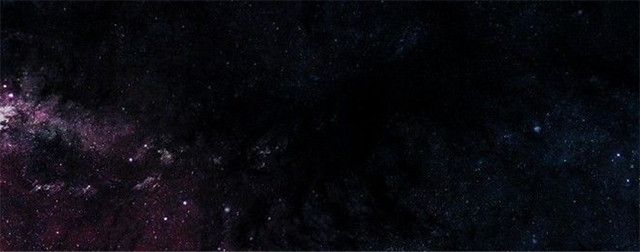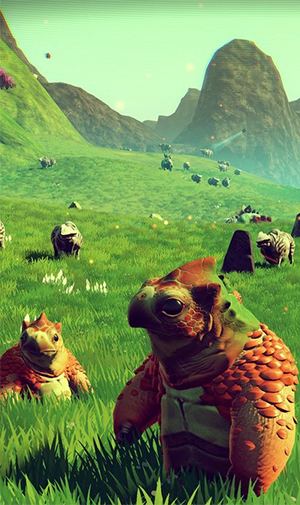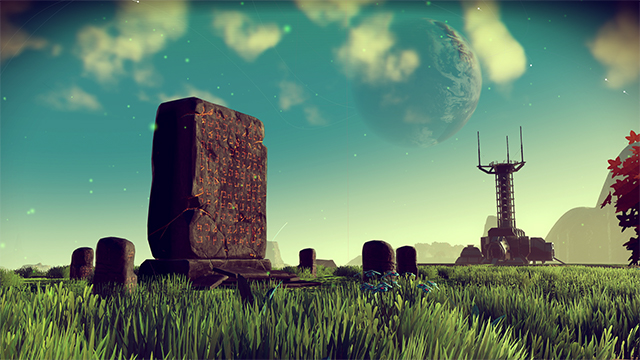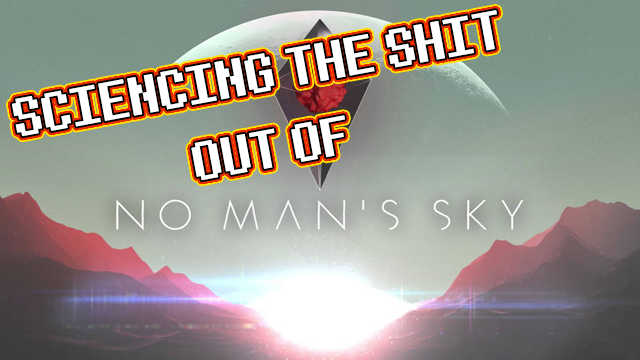Often I’ve thought of what life on alien worlds would look like. Honestly, who hasn’t? The game No Man’s Sky hopes to answer that question in a very dynamic and beautiful way. We’ve all seen the screenshots and videos. It’s looks to be an amazing game. Everything seems to appear the way it should. However, I’ve wondered what science says about it. What should alien worlds look like? Let’s science the shit out of No Man’s Sky planets.
Of course, there are many ideas floating around the scientific community regarding what alien life should look like and how advanced it should be. But I would like to touch on two of them to extrapolate on the accuracy of No Man’s Sky: the Fermi Paradox and Bayesian statistics. Before we get into that, however, you need to know a few pieces of information that will give you an understanding of the scope of this theory.

How many habitable planets are there in the universe?
In the observable universe, there are about an equal number of galaxies as there are stars in our galaxy. And what you and I see in the night with our naked eye is only about 0.0000001% of the stars that are in our galaxy. There are a lot of stars in the sky; I don’t know if you noticed. In fact, there are about 2,500 stars in the sky. If that is 0.0000001% of the stars in the galaxy, that means that there are about 250,000,000,000, stars in our galaxy. And if there are just as many galaxies in the observable universe as there are stars in our galaxy, that means there are 6,250,000,000,000,000,000,000,000 stars in the observable universe. That’s like stacking one dollar bills to the moon 6 trillion times. Or about 10,000 stars for every grain of sand on every beach on Earth. Needless to say, that’s a mind boggling amount of stars.
The most conservative estimates say that 5% of those stars are sun-like stars and conservative estimates also say that 22% of those stars have Earth-like planets in the habitable zones. No Man’s Sky claims to be able procedurally generate about 18 quintillion which is still less than 1% of the habitable worlds in the observable universe.
 What do those worlds look like?
What do those worlds look like?
Of course, there is no way to know for sure what alien planets will look like, but there is a theory that suggests that aliens would actually be bigger than us and live on smaller planets. It’s referred to as the Big Alien Theory, and it uses Bayesian statistics to extrapolate what alien life would look like. Of course, it’s just speculation, but it’s grounded in good statistical science. And it gives us a good idea of what we should look for when going on the hunt for alien life.
The idea behind the big alien theory is that we can statistically assume that we are a part of the largest group of any sort just because we are a part of a group at all. I’ll use the example given by the astrophysicist Fergus Simpson in his write-up about this theory. He asked if people knew their blood-type. Many would say that they don’t, but it can be assumed that those individuals are likely type A or O. Why is that? Well, 70% of the world’s population falls into one of those categories. However, if we were to put all the blood-types into a hat and asked you to draw one out of a hat, you were only have 50% chance of drawing A or O.
Let me give you another example. If all the people in the world were gathered in one place and I picked one at random to give a prize, most likely that person would be from China (a 1-in-7 chance), but he or she would most certainly be from China, India, or the US (1-in-2 chance). But if I were to give that prize to a random country, there would only be a 1-in-196 chance that it would go to China and only 1-in-65 chance that it would go to China, India, or the US.
Simpson postulates that we are statistically a part of a larger-populated, larger-sized planet. And because the vast majority of planets are smaller in both population and size, he claims that the aliens on that planet are likely bigger.

Applying this to No Man’s Sky
We’ve seen a few playthroughs of No Man’s Sky, but we don’t know the statistics surrounding the planet size, alien size, or anything along that line. However, based on some of the information given to us by creator Sean Murray, we can guess at how accurate No Man’s Sky is to our universe.
I should preface this by saying that No Man’s Sky doesn’t take place in our universe. It has physics similar to ours, but it has a different periodic table and elemental combinations. There are also a higher number of habitable planets in a single system.
If No Man’s Sky took place in our universe, then there are some inaccuracies based on Simpson’s calculations. Many of the creatures with Earth-like parallels are the same size and the intelligent life seems to be the same size or smaller than humans. Although this is likely because it appears that many of the inhabited planets appear to be Earth-sized, which would also be inaccurate according to Simpson.
One of the things that appears to be completely accurate is the number of intelligent species, but not because of Simpson’s calculations but because Fermi Paradox, which in a nutshell claims that many intelligent species will end up reaching an apex long before becoming an interplanetary society, and even if they are interplanetary, they will still end up faltering. This is why we have yet to run into any evidence on Earth that there is alien life at all.
From what little we know of the alien cultures in No Man’s Sky, we can see that many suffered from cataclysmic events. And in that sense, it is very accurate.
Regardless of the inaccuracies, No Man’s Sky is a game that I cannot wait to get my hands on because space, aliens, and science fascinates me. Does it fascinate you, too? Do you think No Man’s Sky is accurate? Did I get it wrong? Science is all about testing and retesting. Where could this theory be better applied? Let me know all your thoughts in the comments below.







Published: May 6, 2016 05:28 am